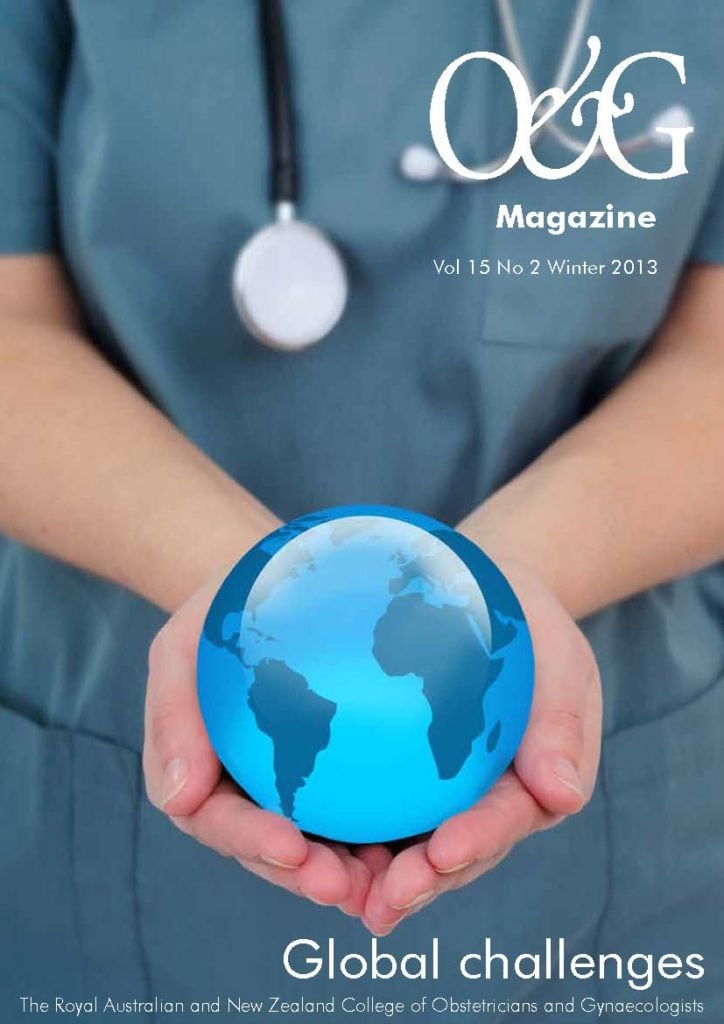Attempts are being made to lift the burden of a disease that falls disproportionally on the world’s poorest countries.
On World Cancer Day 2013, the Global Alliance for Vaccines and Immunisation (GAVI) announced support for the human papillomavirus (HPV) vaccine in eight countries: Ghana, Kenya, Madagascar, Malawi, Niger, Sierra Leone, Tanzania and Lao PDR. This is welcome news indeed for these low-resource countries that carry a high burden from HPV infection.
It has been well established that persistent infection with certain strains of HPV is required for the development of cervical cancer. In the 1970s, study of the epidemiology of cervical cancer recognised a sexually transmitted agent played a role in the causation of cervical cancer. The infectious agent most favoured at the time was herpes.
In 1976, Harald zur Hausen proposed that it was HPV not herpes that was implicated in the causation of cervical cancer. In 1983, zur Hausen identified HPV DNA in cervical cancer tumours. In 2008, he was awarded the Nobel Prize for his research that, having uncovered the cause of cervical cancer, ultimately led to the development of vaccines to prevent disease caused by HPV infection.1
Zur Hausen was the first scientist to develop molecular probes for viruses. In 1974, he used DNA hybridisation and restriction enzyme polymorphisms to initiate the numerical system of HPV typing and to classify strains in plantar and flat warts – HPV 1 to 4. Identification of other HPV types followed. In 1984, the zur Hausen group observed that HPV 18 frequently becomes integrated into host DNA in tumours. They noted that in each case the open reading frames for the oncogenes E6 and E7 are preserved and expressed. This pinpointed the importance of these genes in carcinogenesis. HPV 16 and 18 together were shown to account for approximately 70 per cent of the world’s cervical cancers.1
Since that time, over 130 different types of HPV have been identified, with approximately 40 infecting the anogenital tract. Of those 40 types, approximately 14 have been identified as potentially oncogenic, with HPV 16 and 18 the most frequently found. The natural history of the HPV virus has been extensively examined, though there are still unanswered questions about viral latency and natural immunity. It is, however, clear that in the female genital tract cervical cancer is a rare outcome of a very common infection. The figure widely quoted by the American Social Health Association is that by age 50 years 80 per cent of American women will have acquired at least one type of genital HPV infection.
At the time that HPV was proposed to be the cause of cervical cancers, it was suggested by Syrjanen that a subset of cancers of the oral cavity and larynx may be caused by HPV.2 In 2007, the International Agency for Research on Cancer (IARC) concluded that there was sufficient evidence to support the carcinogenicity of HPV in the penis, anus, oral cavity, oropharynx and tonsils and limited evidence to support carcinogenicity of HPV in the larynx.3
The worldwide prevalence of infection of HPV in women is estimated at 11–12 per cent, with higher rates in sub-Saharan Africa (24 per cent), Eastern Europe (21 per cent) and Latin America (16 per cent).4 Cervical cancer is the only cancer in which HPV infection is the undisputed necessary precondition for its development. Of the 610 000 cancers attributable to HPV worldwide, the vast majority – 530 000 (86.9 per cent) – are cancers of the cervix or uterus.5
Cervical cancer rates show a strong association with level of development. The rate of cervical cancer is many-fold higher in poorly resourced countries than in developed countries; with 86 per cent of cervical cancers occurring in the low-resource countries.6 There is a seven-fold variation in the incidence of cervical cancer between the different regions of the world, with rates ranging from five per 100 000 in Western Asia to 35 per 100 000 in Eastern Africa in 2008. The countries with the highest incidence rates in 2008 were Guinea and Zambia (56 and 53 per 100 000, respectively). Australia has the second-lowest rate in the world at seven per 100 000.6
There were an estimated 275 000 deaths from cervical cancer worldwide in 2008, accounting for eight per cent of all female cancer deaths; 88 per cent of these deaths occurred in developing countries. Worldwide, cervical cancer is the third-most common female malignancy after breast and large bowel cancers and ranked number four in causes of female death after breast, lung and large bowel cancers. Not only is the incidence rate of cervical cancer in developing countries higher, but the five-year survival rate is lower – less than 20 per cent in low-resource countries as opposed to more than 65 per cent in high-resource countries. Australia has the lowest death rate from cervical cancer in the world at less than 2/100 000 while in East Africa it is 25/100 000.4
The five most prevalent types worldwide are HPV 16 (3.27 per cent), HPV 18 (1.4 per cent), HPV 52 (0.9 per cent), HPV 31 (0.8 per cent) and HPV 58 (0.7 per cent).4 As previously mentioned, HPV 16 and 18 account for approximately 70 per cent of all cervical cancers.
Though the evidence for HPV involvement in other cancers, such as oesophageal cancers, was raised at the same time as its role in cervical carcinogenesis, the causal role is not as firmly established except in anal cancer. Unlike cervical cancer, the other cancers are not entirely attributable to HPV. Thus incidence calculations are derived from the proportion of these cancers that are attributable to HPV and the total numbers of those cancers. It is assumed that the incidence is similar in men and women and indeed male genital HPV prevalence has been shown to be generally well correlated with the prevalence of genital HPV in women in the same population.
It is calculated there are approximately 12 000 vulvar cancers, 24 000 anal cancers, 11 000 penile cancers, 9000 vaginal cancers and 22 000 cancers of the oropharynx attributable to HPV worldwide.4
As well as malignant disease, HPV infection imparts a substantial burden in the form of genital warts, which are largely caused by HPV 6 and 11. The incidence is not always easy to estimate as collection of the disease statistics are complex and are not uniformly collected by most countries. An exception is the UK, which has a national reporting system. There was a reported approximate eight-fold increase in the total number of genital warts between 1971 and 2001. This was thought to be due to marked changes in sexual behaviour. The rates of genital warts rose by 15 per cent from 2001–07 in the UK, but appears to have stabilised in the last five years.8 One study in England based on data from general practice and genito-urinary medicine clinics reported 80 531 new and 68 259 recurrent cases in the year 2008. The annual cost of treating genital warts in England was estimated at £16.8 million.9 In Germany in 2005, the cost of treating genital warts was estimated at ¤54.1 million.10 A widely quoted figure from the USA is approximately US$200 million per year.
Following large trials, a quadrivalent vaccine, Gardasil®, covering HPV 6, 11, 16 and 18 was first licensed for sale in mid 2006, followed in 2007 by bivalent vaccine Cervarix®, covering HPV 16 and 18. In April 2007, Australia became the first country to introduce a government-funded national HPV vaccination program for young women. This has been replicated by other well-resourced countries – including New Zealand, the UK, most of Western Europe and many provinces in Canada. In the USA, vaccination is both privately and publicly funded.
However, these countries have well-established screening programs and already low rates of mortality from cervical cancer. The vaccine is going to be most effective in countries that are not so privileged. Fortunately, through a variety of charitable mechanisms, including the Gardasil Access Program funded by Merck in partnership with organisations such as GAVI and the Australian Cancer Foundation, the vaccine is being delivered to the poorly resourced areas of the world such as Rwanda and Uganda, where cervical cancer is the most common cancer diagnosed in women and the incidence more than three times the global average.
The burden of HPV infection is significant globally, being responsible for two and seven per cent of the total cancer burden in more-developed and less-developed countries, respectively.11 Until now, better resourced countries have been able to reduce the burden by screening and early treatment. With the advent of vaccines an opportunity exists to reduce this burden worldwide.
References
- Weiss R. On viruses, Discovery, and Recognition. Cell 2008; 135(6): 983-986.
- Syrjänen K et al. Morphological and immunohistochemical evidence suggesting human papillomavirus (HPV) involvement in oral squamous cell carcinogenesis. Int J Oral Surg. 1983 Dec;12(6):418-24.
- Proceedings of the IARC Working Group on the Evaluation of carcinogenic Risks to Humans. Biological Agents. Lyon, France, 2009IARC Monogr Eval Carcinog Risks Hum Vol 100B 2011
- Bruni L et al. Cervical human papillomavirus prevalence in 5 continents: meta-analysis of 1 million women with normal cytological findings. J Infect Dis 2010;202:1789–99
- Ferlay J et al. Estimates of worldwide burden of cancer in 2008:GLOBOCAN 2008. Int J Cancer 2010;127:2893–917.
- Arbyn M et al. Worldwide burden of cervical cancer in 2008. AnnOncol 2011;22:2675–83.
- Forman D et al. Global Burden of Human Papilloma virus and related diseases. Vaccine 2012: 30 Suppl 5: F12-23.
- Lacey CJN et al. Burden and management of non-cancerous HPV-related conditions: HPV-6/11 disease. Vaccine2006;24(Suppl.3):S35–41.
- Desai S et al. Genital warts and cost of care in England. Sex TransmInfect. 2011 Oct;87(6):464-8.
- Hillemanns P et al. Estimation of the incidence of genital warts andthe cost of illness in Germany: a cross-sectional study. BMC Infect Dis.2008 Jun 2;8:76.
- De Martel C et al. The global burden of cancers attributable toinfections in the year 2008: a review and synthetic analysis. LancetOncol 2012;13:607–15.






Leave a Reply